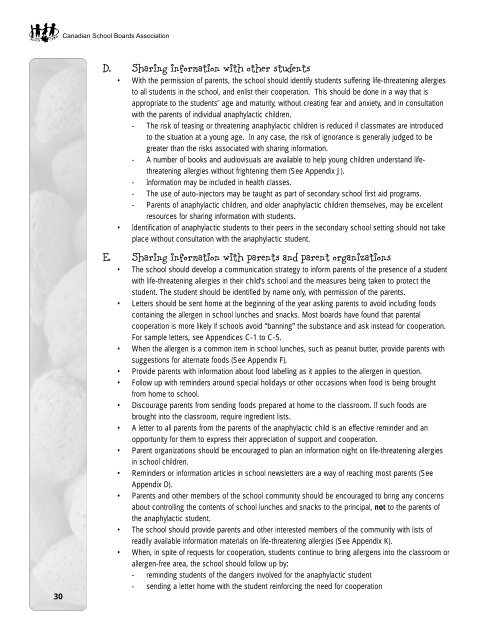Anaphylaxis - Canadian School Boards Association
Anaphylaxis - Canadian School Boards Association
Anaphylaxis - Canadian School Boards Association
Create successful ePaper yourself
Turn your PDF publications into a flip-book with our unique Google optimized e-Paper software.
<strong>Canadian</strong> <strong>School</strong> <strong>Boards</strong> <strong>Association</strong>30D. Sharing information with other students• With the permission of parents, the school should identify students suffering life-threatening allergiesto all students in the school, and enlist their cooperation. This should be done in a way that isappropriate to the students’ age and maturity, without creating fear and anxiety, and in consultationwith the parents of individual anaphylactic children.- The risk of teasing or threatening anaphylactic children is reduced if classmates are introducedto the situation at a young age. In any case, the risk of ignorance is generally judged to begreater than the risks associated with sharing information.- A number of books and audiovisuals are available to help young children understand lifethreateningallergies without frightening them (See Appendix J).- Information may be included in health classes.- The use of auto-injectors may be taught as part of secondary school first aid programs.- Parents of anaphylactic children, and older anaphylactic children themselves, may be excellentresources for sharing information with students.• Identification of anaphylactic students to their peers in the secondary school setting should not takeplace without consultation with the anaphylactic student.E. Sharing information with parents and parent organizations• The school should develop a communication strategy to inform parents of the presence of a studentwith life-threatening allergies in their child’s school and the measures being taken to protect thestudent. The student should be identified by name only, with permission of the parents.• Letters should be sent home at the beginning of the year asking parents to avoid including foodscontaining the allergen in school lunches and snacks. Most boards have found that parentalcooperation is more likely if schools avoid “banning” the substance and ask instead for cooperation.For sample letters, see Appendices C-1 to C-5.• When the allergen is a common item in school lunches, such as peanut butter, provide parents withsuggestions for alternate foods (See Appendix F).• Provide parents with information about food labelling as it applies to the allergen in question.• Follow up with reminders around special holidays or other occasions when food is being broughtfrom home to school.• Discourage parents from sending foods prepared at home to the classroom. If such foods arebrought into the classroom, require ingredient lists.• A letter to all parents from the parents of the anaphylactic child is an effective reminder and anopportunity for them to express their appreciation of support and cooperation.• Parent organizations should be encouraged to plan an information night on life-threatening allergiesin school children.• Reminders or information articles in school newsletters are a way of reaching most parents (SeeAppendix D).• Parents and other members of the school community should be encouraged to bring any concernsabout controlling the contents of school lunches and snacks to the principal, not to the parents ofthe anaphylactic student.• The school should provide parents and other interested members of the community with lists ofreadily available information materials on life-threatening allergies (See Appendix K).• When, in spite of requests for cooperation, students continue to bring allergens into the classroom orallergen-free area, the school should follow up by:- reminding students of the dangers involved for the anaphylactic student- sending a letter home with the student reinforcing the need for cooperation


